Human Services Standards: NDIS Provider Self-Assessment Report
VerifiedAdded on 2020/05/03
|30
|8970
|60
Report
AI Summary
This self-assessment report, submitted by Solomon Fraternity, evaluates its adherence to the National Disability Insurance Scheme (NDIS) service standards. It covers three key standards: Empowerment, Access and Engagement, and referral pathways. The report provides detailed evidence indicators, documentation, and knowledge awareness to support each criterion. It includes self-assessment ratings (Met/Part Met/Not Met) for each criterion and outlines actions required for quality improvement. The report emphasizes the importance of people's rights and responsibilities, ensuring fair, equitable, and transparent service delivery, and providing timely, responsive service integration. The report also highlights the need for continuous quality improvement, with a focus on family involvement and regular reviews of service delivery processes. The document also emphasizes the importance of staff training, awareness, and the use of data to inform planning and address service access barriers, ensuring that services are delivered in a fair, equitable and transparent manner.
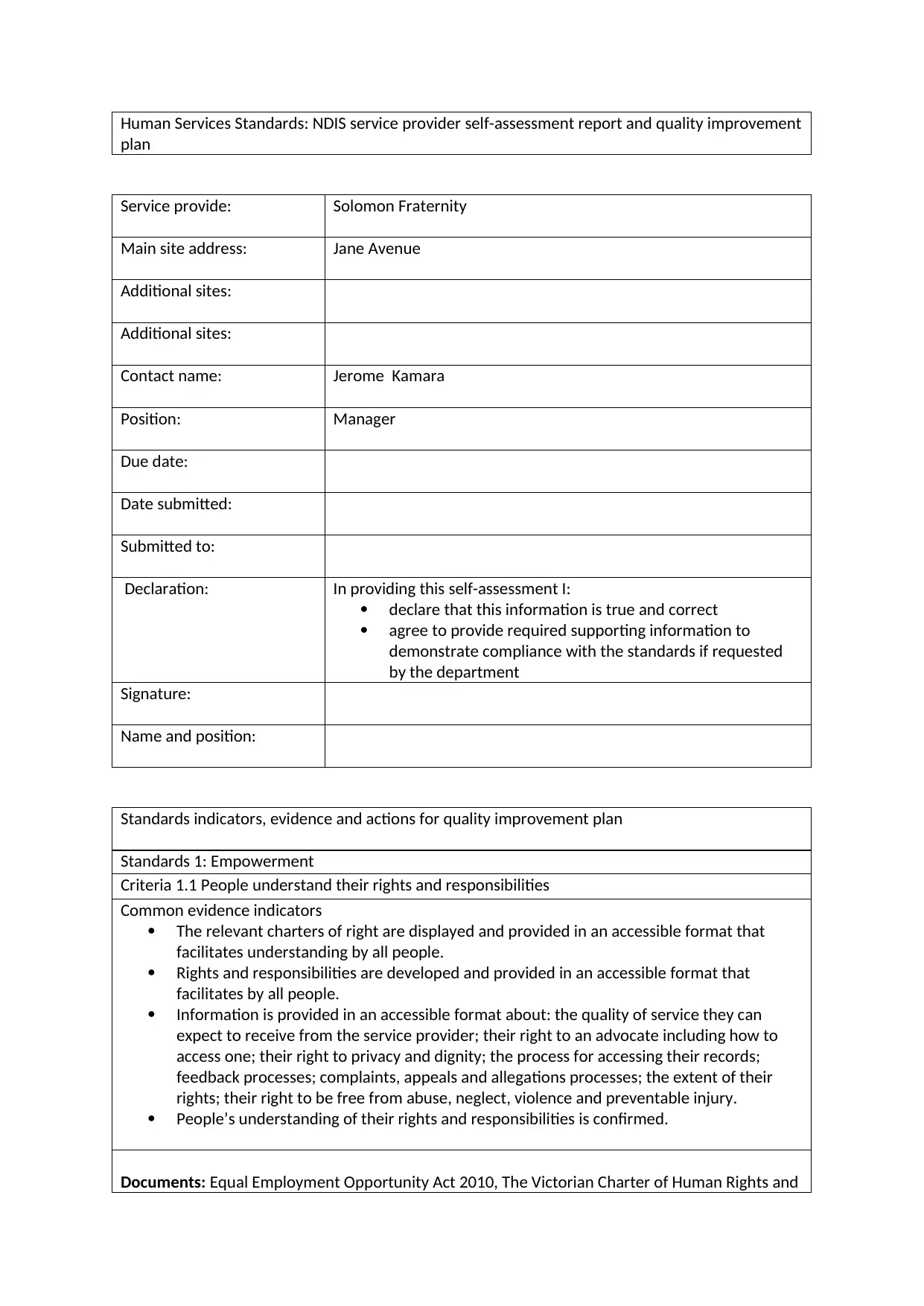
Human Services Standards: NDIS service provider self-assessment report and quality improvement
plan
Service provide: Solomon Fraternity
Main site address: Jane Avenue
Additional sites:
Additional sites:
Contact name: Jerome Kamara
Position: Manager
Due date:
Date submitted:
Submitted to:
Declaration: In providing this self-assessment I:
declare that this information is true and correct
agree to provide required supporting information to
demonstrate compliance with the standards if requested
by the department
Signature:
Name and position:
Standards indicators, evidence and actions for quality improvement plan
Standards 1: Empowerment
Criteria 1.1 People understand their rights and responsibilities
Common evidence indicators
The relevant charters of right are displayed and provided in an accessible format that
facilitates understanding by all people.
Rights and responsibilities are developed and provided in an accessible format that
facilitates by all people.
Information is provided in an accessible format about: the quality of service they can
expect to receive from the service provider; their right to an advocate including how to
access one; their right to privacy and dignity; the process for accessing their records;
feedback processes; complaints, appeals and allegations processes; the extent of their
rights; their right to be free from abuse, neglect, violence and preventable injury.
People’s understanding of their rights and responsibilities is confirmed.
Documents: Equal Employment Opportunity Act 2010, The Victorian Charter of Human Rights and
plan
Service provide: Solomon Fraternity
Main site address: Jane Avenue
Additional sites:
Additional sites:
Contact name: Jerome Kamara
Position: Manager
Due date:
Date submitted:
Submitted to:
Declaration: In providing this self-assessment I:
declare that this information is true and correct
agree to provide required supporting information to
demonstrate compliance with the standards if requested
by the department
Signature:
Name and position:
Standards indicators, evidence and actions for quality improvement plan
Standards 1: Empowerment
Criteria 1.1 People understand their rights and responsibilities
Common evidence indicators
The relevant charters of right are displayed and provided in an accessible format that
facilitates understanding by all people.
Rights and responsibilities are developed and provided in an accessible format that
facilitates by all people.
Information is provided in an accessible format about: the quality of service they can
expect to receive from the service provider; their right to an advocate including how to
access one; their right to privacy and dignity; the process for accessing their records;
feedback processes; complaints, appeals and allegations processes; the extent of their
rights; their right to be free from abuse, neglect, violence and preventable injury.
People’s understanding of their rights and responsibilities is confirmed.
Documents: Equal Employment Opportunity Act 2010, The Victorian Charter of Human Rights and
Paraphrase This Document
Need a fresh take? Get an instant paraphrase of this document with our AI Paraphraser
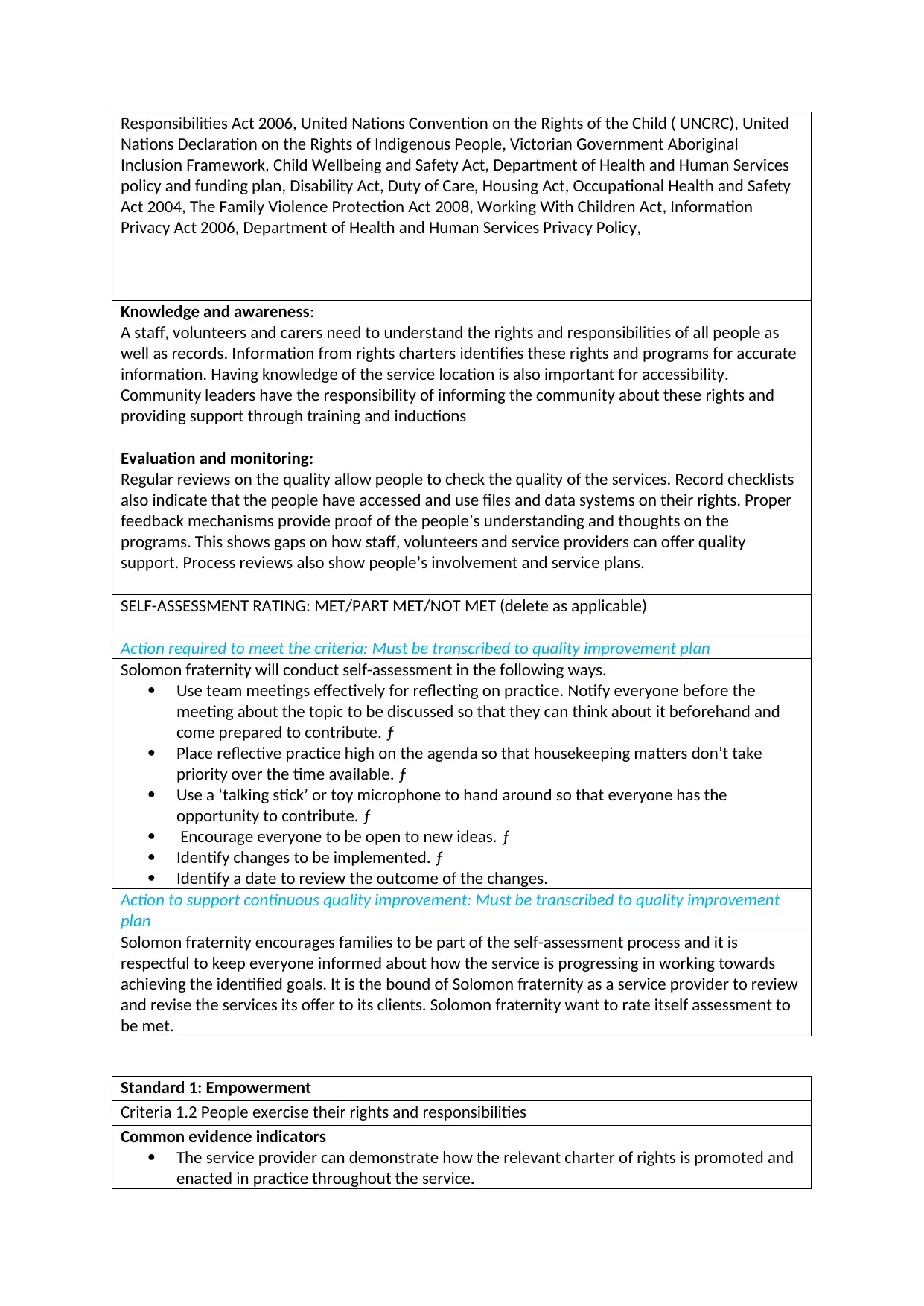
Responsibilities Act 2006, United Nations Convention on the Rights of the Child ( UNCRC), United
Nations Declaration on the Rights of Indigenous People, Victorian Government Aboriginal
Inclusion Framework, Child Wellbeing and Safety Act, Department of Health and Human Services
policy and funding plan, Disability Act, Duty of Care, Housing Act, Occupational Health and Safety
Act 2004, The Family Violence Protection Act 2008, Working With Children Act, Information
Privacy Act 2006, Department of Health and Human Services Privacy Policy,
Knowledge and awareness:
A staff, volunteers and carers need to understand the rights and responsibilities of all people as
well as records. Information from rights charters identifies these rights and programs for accurate
information. Having knowledge of the service location is also important for accessibility.
Community leaders have the responsibility of informing the community about these rights and
providing support through training and inductions
Evaluation and monitoring:
Regular reviews on the quality allow people to check the quality of the services. Record checklists
also indicate that the people have accessed and use files and data systems on their rights. Proper
feedback mechanisms provide proof of the people’s understanding and thoughts on the
programs. This shows gaps on how staff, volunteers and service providers can offer quality
support. Process reviews also show people’s involvement and service plans.
SELF-ASSESSMENT RATING: MET/PART MET/NOT MET (delete as applicable)
Action required to meet the criteria: Must be transcribed to quality improvement plan
Solomon fraternity will conduct self-assessment in the following ways.
Use team meetings effectively for reflecting on practice. Notify everyone before the
meeting about the topic to be discussed so that they can think about it beforehand and
come prepared to contribute. ƒ
Place reflective practice high on the agenda so that housekeeping matters don’t take
priority over the time available. ƒ
Use a ‘talking stick’ or toy microphone to hand around so that everyone has the
opportunity to contribute. ƒ
Encourage everyone to be open to new ideas. ƒ
Identify changes to be implemented. ƒ
Identify a date to review the outcome of the changes.
Action to support continuous quality improvement: Must be transcribed to quality improvement
plan
Solomon fraternity encourages families to be part of the self-assessment process and it is
respectful to keep everyone informed about how the service is progressing in working towards
achieving the identified goals. It is the bound of Solomon fraternity as a service provider to review
and revise the services its offer to its clients. Solomon fraternity want to rate itself assessment to
be met.
Standard 1: Empowerment
Criteria 1.2 People exercise their rights and responsibilities
Common evidence indicators
The service provider can demonstrate how the relevant charter of rights is promoted and
enacted in practice throughout the service.
Nations Declaration on the Rights of Indigenous People, Victorian Government Aboriginal
Inclusion Framework, Child Wellbeing and Safety Act, Department of Health and Human Services
policy and funding plan, Disability Act, Duty of Care, Housing Act, Occupational Health and Safety
Act 2004, The Family Violence Protection Act 2008, Working With Children Act, Information
Privacy Act 2006, Department of Health and Human Services Privacy Policy,
Knowledge and awareness:
A staff, volunteers and carers need to understand the rights and responsibilities of all people as
well as records. Information from rights charters identifies these rights and programs for accurate
information. Having knowledge of the service location is also important for accessibility.
Community leaders have the responsibility of informing the community about these rights and
providing support through training and inductions
Evaluation and monitoring:
Regular reviews on the quality allow people to check the quality of the services. Record checklists
also indicate that the people have accessed and use files and data systems on their rights. Proper
feedback mechanisms provide proof of the people’s understanding and thoughts on the
programs. This shows gaps on how staff, volunteers and service providers can offer quality
support. Process reviews also show people’s involvement and service plans.
SELF-ASSESSMENT RATING: MET/PART MET/NOT MET (delete as applicable)
Action required to meet the criteria: Must be transcribed to quality improvement plan
Solomon fraternity will conduct self-assessment in the following ways.
Use team meetings effectively for reflecting on practice. Notify everyone before the
meeting about the topic to be discussed so that they can think about it beforehand and
come prepared to contribute. ƒ
Place reflective practice high on the agenda so that housekeeping matters don’t take
priority over the time available. ƒ
Use a ‘talking stick’ or toy microphone to hand around so that everyone has the
opportunity to contribute. ƒ
Encourage everyone to be open to new ideas. ƒ
Identify changes to be implemented. ƒ
Identify a date to review the outcome of the changes.
Action to support continuous quality improvement: Must be transcribed to quality improvement
plan
Solomon fraternity encourages families to be part of the self-assessment process and it is
respectful to keep everyone informed about how the service is progressing in working towards
achieving the identified goals. It is the bound of Solomon fraternity as a service provider to review
and revise the services its offer to its clients. Solomon fraternity want to rate itself assessment to
be met.
Standard 1: Empowerment
Criteria 1.2 People exercise their rights and responsibilities
Common evidence indicators
The service provider can demonstrate how the relevant charter of rights is promoted and
enacted in practice throughout the service.
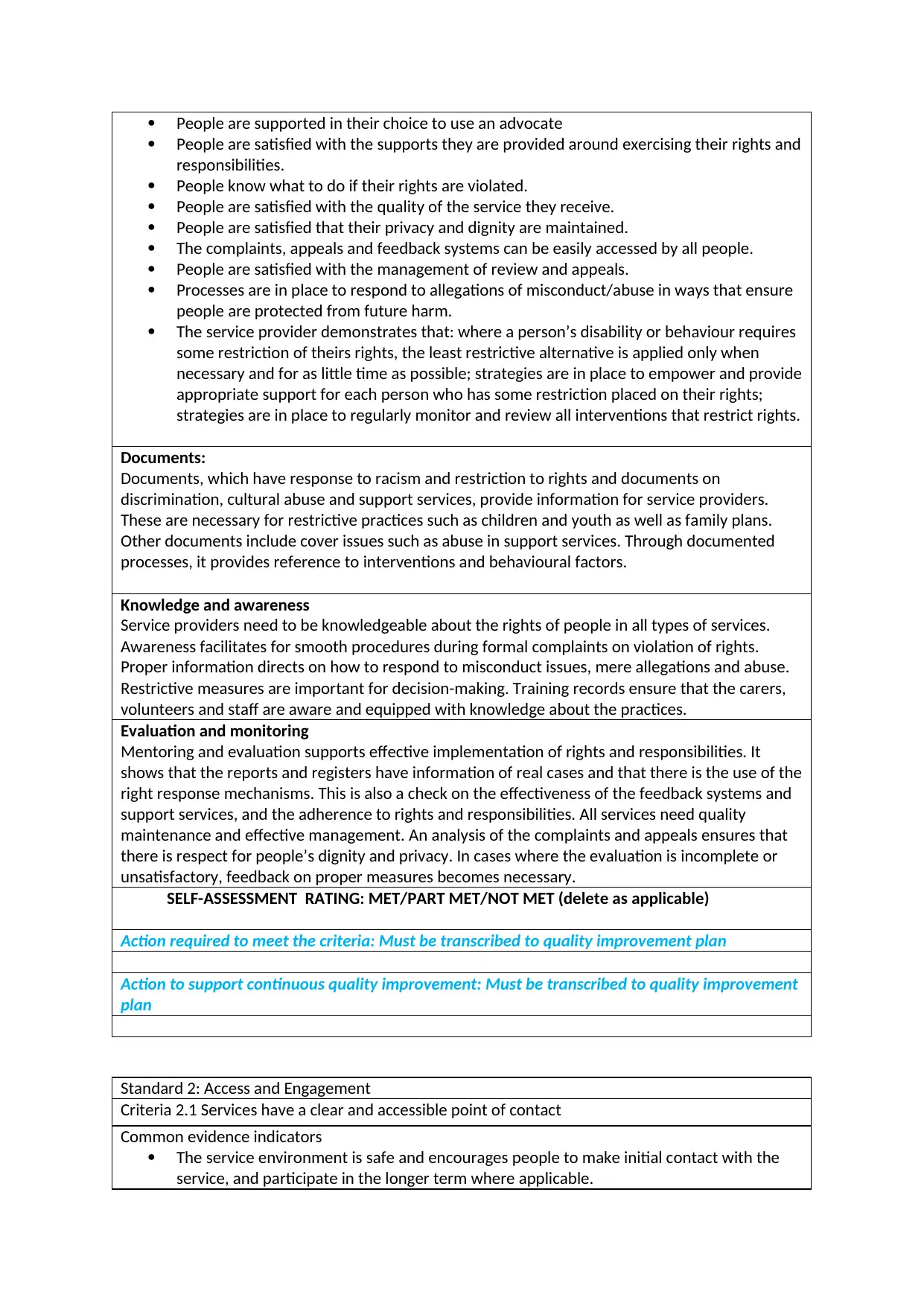
People are supported in their choice to use an advocate
People are satisfied with the supports they are provided around exercising their rights and
responsibilities.
People know what to do if their rights are violated.
People are satisfied with the quality of the service they receive.
People are satisfied that their privacy and dignity are maintained.
The complaints, appeals and feedback systems can be easily accessed by all people.
People are satisfied with the management of review and appeals.
Processes are in place to respond to allegations of misconduct/abuse in ways that ensure
people are protected from future harm.
The service provider demonstrates that: where a person’s disability or behaviour requires
some restriction of theirs rights, the least restrictive alternative is applied only when
necessary and for as little time as possible; strategies are in place to empower and provide
appropriate support for each person who has some restriction placed on their rights;
strategies are in place to regularly monitor and review all interventions that restrict rights.
Documents:
Documents, which have response to racism and restriction to rights and documents on
discrimination, cultural abuse and support services, provide information for service providers.
These are necessary for restrictive practices such as children and youth as well as family plans.
Other documents include cover issues such as abuse in support services. Through documented
processes, it provides reference to interventions and behavioural factors.
Knowledge and awareness
Service providers need to be knowledgeable about the rights of people in all types of services.
Awareness facilitates for smooth procedures during formal complaints on violation of rights.
Proper information directs on how to respond to misconduct issues, mere allegations and abuse.
Restrictive measures are important for decision-making. Training records ensure that the carers,
volunteers and staff are aware and equipped with knowledge about the practices.
Evaluation and monitoring
Mentoring and evaluation supports effective implementation of rights and responsibilities. It
shows that the reports and registers have information of real cases and that there is the use of the
right response mechanisms. This is also a check on the effectiveness of the feedback systems and
support services, and the adherence to rights and responsibilities. All services need quality
maintenance and effective management. An analysis of the complaints and appeals ensures that
there is respect for people’s dignity and privacy. In cases where the evaluation is incomplete or
unsatisfactory, feedback on proper measures becomes necessary.
SELF-ASSESSMENT RATING: MET/PART MET/NOT MET (delete as applicable)
Action required to meet the criteria: Must be transcribed to quality improvement plan
Action to support continuous quality improvement: Must be transcribed to quality improvement
plan
Standard 2: Access and Engagement
Criteria 2.1 Services have a clear and accessible point of contact
Common evidence indicators
The service environment is safe and encourages people to make initial contact with the
service, and participate in the longer term where applicable.
People are satisfied with the supports they are provided around exercising their rights and
responsibilities.
People know what to do if their rights are violated.
People are satisfied with the quality of the service they receive.
People are satisfied that their privacy and dignity are maintained.
The complaints, appeals and feedback systems can be easily accessed by all people.
People are satisfied with the management of review and appeals.
Processes are in place to respond to allegations of misconduct/abuse in ways that ensure
people are protected from future harm.
The service provider demonstrates that: where a person’s disability or behaviour requires
some restriction of theirs rights, the least restrictive alternative is applied only when
necessary and for as little time as possible; strategies are in place to empower and provide
appropriate support for each person who has some restriction placed on their rights;
strategies are in place to regularly monitor and review all interventions that restrict rights.
Documents:
Documents, which have response to racism and restriction to rights and documents on
discrimination, cultural abuse and support services, provide information for service providers.
These are necessary for restrictive practices such as children and youth as well as family plans.
Other documents include cover issues such as abuse in support services. Through documented
processes, it provides reference to interventions and behavioural factors.
Knowledge and awareness
Service providers need to be knowledgeable about the rights of people in all types of services.
Awareness facilitates for smooth procedures during formal complaints on violation of rights.
Proper information directs on how to respond to misconduct issues, mere allegations and abuse.
Restrictive measures are important for decision-making. Training records ensure that the carers,
volunteers and staff are aware and equipped with knowledge about the practices.
Evaluation and monitoring
Mentoring and evaluation supports effective implementation of rights and responsibilities. It
shows that the reports and registers have information of real cases and that there is the use of the
right response mechanisms. This is also a check on the effectiveness of the feedback systems and
support services, and the adherence to rights and responsibilities. All services need quality
maintenance and effective management. An analysis of the complaints and appeals ensures that
there is respect for people’s dignity and privacy. In cases where the evaluation is incomplete or
unsatisfactory, feedback on proper measures becomes necessary.
SELF-ASSESSMENT RATING: MET/PART MET/NOT MET (delete as applicable)
Action required to meet the criteria: Must be transcribed to quality improvement plan
Action to support continuous quality improvement: Must be transcribed to quality improvement
plan
Standard 2: Access and Engagement
Criteria 2.1 Services have a clear and accessible point of contact
Common evidence indicators
The service environment is safe and encourages people to make initial contact with the
service, and participate in the longer term where applicable.
⊘ This is a preview!⊘
Do you want full access?
Subscribe today to unlock all pages.

Trusted by 1+ million students worldwide
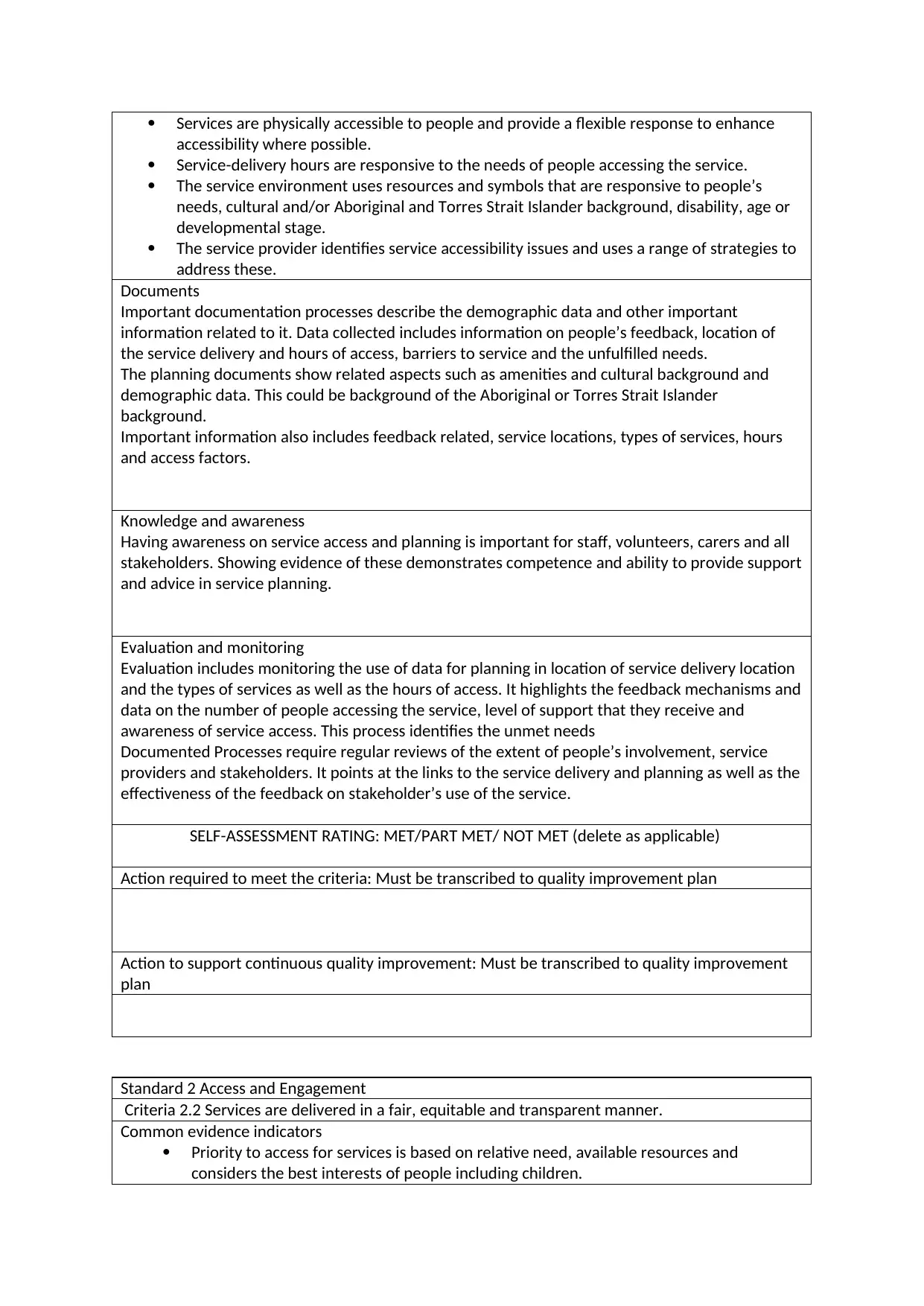
Services are physically accessible to people and provide a flexible response to enhance
accessibility where possible.
Service-delivery hours are responsive to the needs of people accessing the service.
The service environment uses resources and symbols that are responsive to people’s
needs, cultural and/or Aboriginal and Torres Strait Islander background, disability, age or
developmental stage.
The service provider identifies service accessibility issues and uses a range of strategies to
address these.
Documents
Important documentation processes describe the demographic data and other important
information related to it. Data collected includes information on people’s feedback, location of
the service delivery and hours of access, barriers to service and the unfulfilled needs.
The planning documents show related aspects such as amenities and cultural background and
demographic data. This could be background of the Aboriginal or Torres Strait Islander
background.
Important information also includes feedback related, service locations, types of services, hours
and access factors.
Knowledge and awareness
Having awareness on service access and planning is important for staff, volunteers, carers and all
stakeholders. Showing evidence of these demonstrates competence and ability to provide support
and advice in service planning.
Evaluation and monitoring
Evaluation includes monitoring the use of data for planning in location of service delivery location
and the types of services as well as the hours of access. It highlights the feedback mechanisms and
data on the number of people accessing the service, level of support that they receive and
awareness of service access. This process identifies the unmet needs
Documented Processes require regular reviews of the extent of people’s involvement, service
providers and stakeholders. It points at the links to the service delivery and planning as well as the
effectiveness of the feedback on stakeholder’s use of the service.
SELF-ASSESSMENT RATING: MET/PART MET/ NOT MET (delete as applicable)
Action required to meet the criteria: Must be transcribed to quality improvement plan
Action to support continuous quality improvement: Must be transcribed to quality improvement
plan
Standard 2 Access and Engagement
Criteria 2.2 Services are delivered in a fair, equitable and transparent manner.
Common evidence indicators
Priority to access for services is based on relative need, available resources and
considers the best interests of people including children.
accessibility where possible.
Service-delivery hours are responsive to the needs of people accessing the service.
The service environment uses resources and symbols that are responsive to people’s
needs, cultural and/or Aboriginal and Torres Strait Islander background, disability, age or
developmental stage.
The service provider identifies service accessibility issues and uses a range of strategies to
address these.
Documents
Important documentation processes describe the demographic data and other important
information related to it. Data collected includes information on people’s feedback, location of
the service delivery and hours of access, barriers to service and the unfulfilled needs.
The planning documents show related aspects such as amenities and cultural background and
demographic data. This could be background of the Aboriginal or Torres Strait Islander
background.
Important information also includes feedback related, service locations, types of services, hours
and access factors.
Knowledge and awareness
Having awareness on service access and planning is important for staff, volunteers, carers and all
stakeholders. Showing evidence of these demonstrates competence and ability to provide support
and advice in service planning.
Evaluation and monitoring
Evaluation includes monitoring the use of data for planning in location of service delivery location
and the types of services as well as the hours of access. It highlights the feedback mechanisms and
data on the number of people accessing the service, level of support that they receive and
awareness of service access. This process identifies the unmet needs
Documented Processes require regular reviews of the extent of people’s involvement, service
providers and stakeholders. It points at the links to the service delivery and planning as well as the
effectiveness of the feedback on stakeholder’s use of the service.
SELF-ASSESSMENT RATING: MET/PART MET/ NOT MET (delete as applicable)
Action required to meet the criteria: Must be transcribed to quality improvement plan
Action to support continuous quality improvement: Must be transcribed to quality improvement
plan
Standard 2 Access and Engagement
Criteria 2.2 Services are delivered in a fair, equitable and transparent manner.
Common evidence indicators
Priority to access for services is based on relative need, available resources and
considers the best interests of people including children.
Paraphrase This Document
Need a fresh take? Get an instant paraphrase of this document with our AI Paraphraser
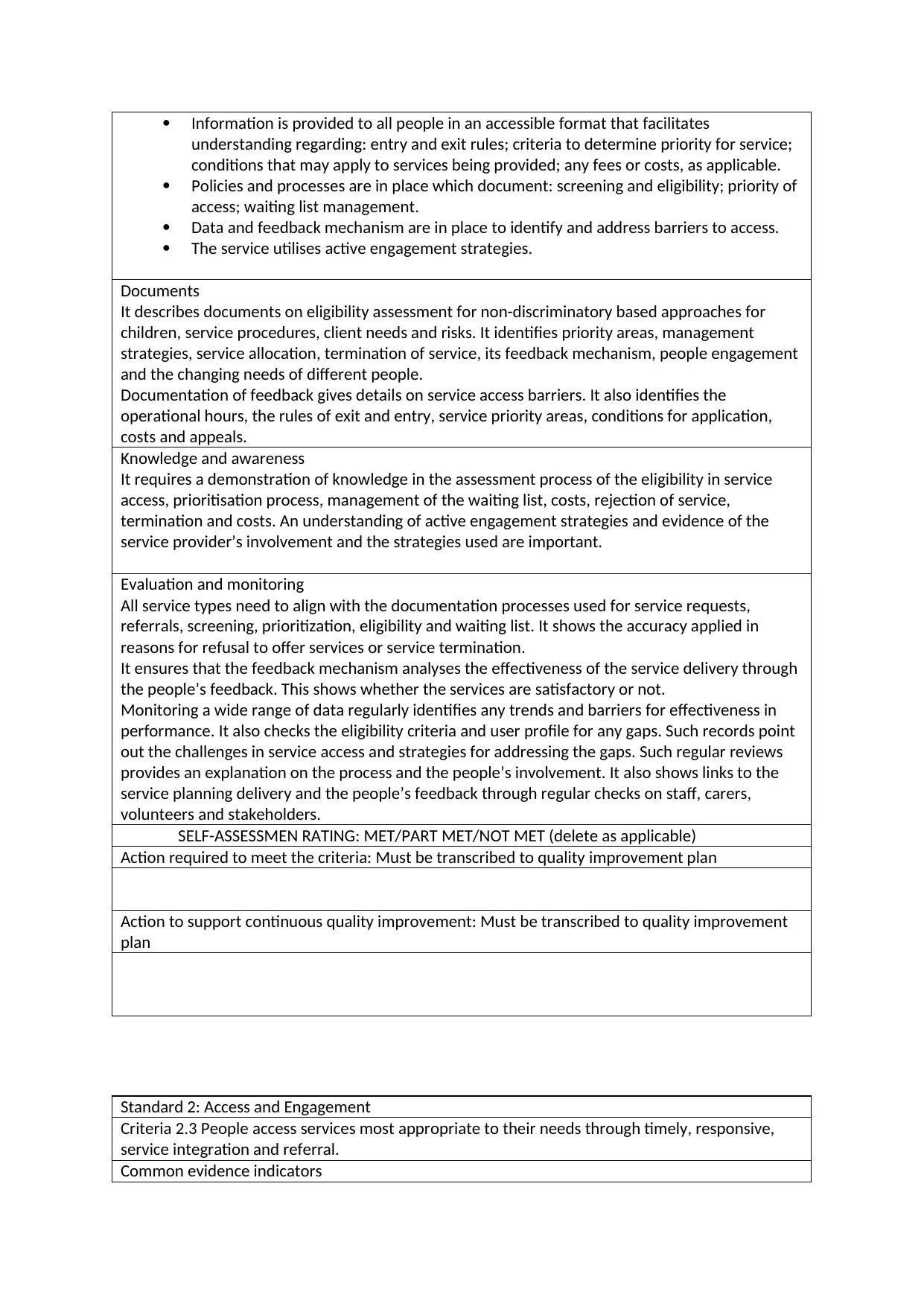
Information is provided to all people in an accessible format that facilitates
understanding regarding: entry and exit rules; criteria to determine priority for service;
conditions that may apply to services being provided; any fees or costs, as applicable.
Policies and processes are in place which document: screening and eligibility; priority of
access; waiting list management.
Data and feedback mechanism are in place to identify and address barriers to access.
The service utilises active engagement strategies.
Documents
It describes documents on eligibility assessment for non-discriminatory based approaches for
children, service procedures, client needs and risks. It identifies priority areas, management
strategies, service allocation, termination of service, its feedback mechanism, people engagement
and the changing needs of different people.
Documentation of feedback gives details on service access barriers. It also identifies the
operational hours, the rules of exit and entry, service priority areas, conditions for application,
costs and appeals.
Knowledge and awareness
It requires a demonstration of knowledge in the assessment process of the eligibility in service
access, prioritisation process, management of the waiting list, costs, rejection of service,
termination and costs. An understanding of active engagement strategies and evidence of the
service provider’s involvement and the strategies used are important.
Evaluation and monitoring
All service types need to align with the documentation processes used for service requests,
referrals, screening, prioritization, eligibility and waiting list. It shows the accuracy applied in
reasons for refusal to offer services or service termination.
It ensures that the feedback mechanism analyses the effectiveness of the service delivery through
the people’s feedback. This shows whether the services are satisfactory or not.
Monitoring a wide range of data regularly identifies any trends and barriers for effectiveness in
performance. It also checks the eligibility criteria and user profile for any gaps. Such records point
out the challenges in service access and strategies for addressing the gaps. Such regular reviews
provides an explanation on the process and the people’s involvement. It also shows links to the
service planning delivery and the people’s feedback through regular checks on staff, carers,
volunteers and stakeholders.
SELF-ASSESSMEN RATING: MET/PART MET/NOT MET (delete as applicable)
Action required to meet the criteria: Must be transcribed to quality improvement plan
Action to support continuous quality improvement: Must be transcribed to quality improvement
plan
Standard 2: Access and Engagement
Criteria 2.3 People access services most appropriate to their needs through timely, responsive,
service integration and referral.
Common evidence indicators
understanding regarding: entry and exit rules; criteria to determine priority for service;
conditions that may apply to services being provided; any fees or costs, as applicable.
Policies and processes are in place which document: screening and eligibility; priority of
access; waiting list management.
Data and feedback mechanism are in place to identify and address barriers to access.
The service utilises active engagement strategies.
Documents
It describes documents on eligibility assessment for non-discriminatory based approaches for
children, service procedures, client needs and risks. It identifies priority areas, management
strategies, service allocation, termination of service, its feedback mechanism, people engagement
and the changing needs of different people.
Documentation of feedback gives details on service access barriers. It also identifies the
operational hours, the rules of exit and entry, service priority areas, conditions for application,
costs and appeals.
Knowledge and awareness
It requires a demonstration of knowledge in the assessment process of the eligibility in service
access, prioritisation process, management of the waiting list, costs, rejection of service,
termination and costs. An understanding of active engagement strategies and evidence of the
service provider’s involvement and the strategies used are important.
Evaluation and monitoring
All service types need to align with the documentation processes used for service requests,
referrals, screening, prioritization, eligibility and waiting list. It shows the accuracy applied in
reasons for refusal to offer services or service termination.
It ensures that the feedback mechanism analyses the effectiveness of the service delivery through
the people’s feedback. This shows whether the services are satisfactory or not.
Monitoring a wide range of data regularly identifies any trends and barriers for effectiveness in
performance. It also checks the eligibility criteria and user profile for any gaps. Such records point
out the challenges in service access and strategies for addressing the gaps. Such regular reviews
provides an explanation on the process and the people’s involvement. It also shows links to the
service planning delivery and the people’s feedback through regular checks on staff, carers,
volunteers and stakeholders.
SELF-ASSESSMEN RATING: MET/PART MET/NOT MET (delete as applicable)
Action required to meet the criteria: Must be transcribed to quality improvement plan
Action to support continuous quality improvement: Must be transcribed to quality improvement
plan
Standard 2: Access and Engagement
Criteria 2.3 People access services most appropriate to their needs through timely, responsive,
service integration and referral.
Common evidence indicators
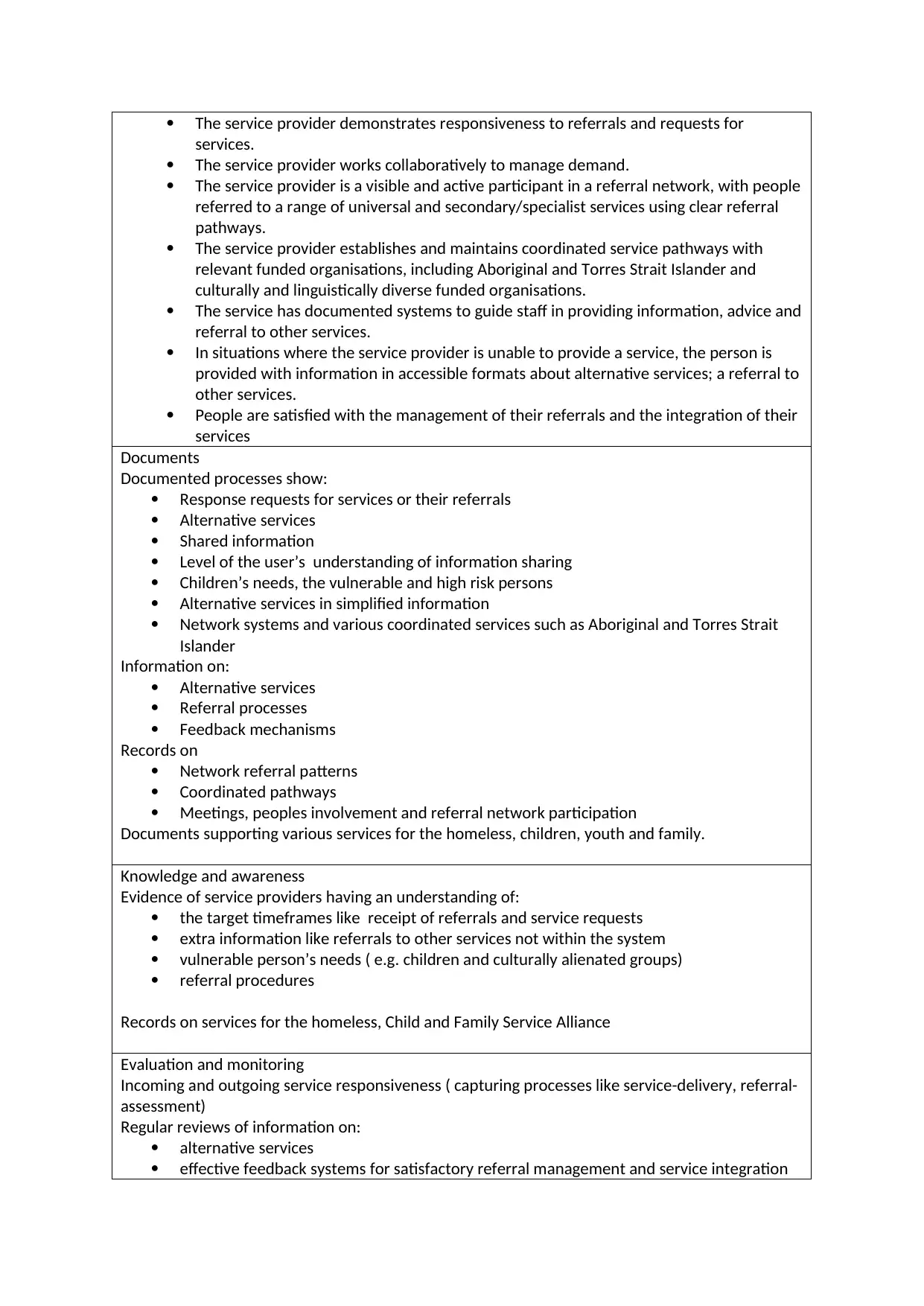
The service provider demonstrates responsiveness to referrals and requests for
services.
The service provider works collaboratively to manage demand.
The service provider is a visible and active participant in a referral network, with people
referred to a range of universal and secondary/specialist services using clear referral
pathways.
The service provider establishes and maintains coordinated service pathways with
relevant funded organisations, including Aboriginal and Torres Strait Islander and
culturally and linguistically diverse funded organisations.
The service has documented systems to guide staff in providing information, advice and
referral to other services.
In situations where the service provider is unable to provide a service, the person is
provided with information in accessible formats about alternative services; a referral to
other services.
People are satisfied with the management of their referrals and the integration of their
services
Documents
Documented processes show:
Response requests for services or their referrals
Alternative services
Shared information
Level of the user’s understanding of information sharing
Children’s needs, the vulnerable and high risk persons
Alternative services in simplified information
Network systems and various coordinated services such as Aboriginal and Torres Strait
Islander
Information on:
Alternative services
Referral processes
Feedback mechanisms
Records on
Network referral patterns
Coordinated pathways
Meetings, peoples involvement and referral network participation
Documents supporting various services for the homeless, children, youth and family.
Knowledge and awareness
Evidence of service providers having an understanding of:
the target timeframes like receipt of referrals and service requests
extra information like referrals to other services not within the system
vulnerable person’s needs ( e.g. children and culturally alienated groups)
referral procedures
Records on services for the homeless, Child and Family Service Alliance
Evaluation and monitoring
Incoming and outgoing service responsiveness ( capturing processes like service-delivery, referral-
assessment)
Regular reviews of information on:
alternative services
effective feedback systems for satisfactory referral management and service integration
services.
The service provider works collaboratively to manage demand.
The service provider is a visible and active participant in a referral network, with people
referred to a range of universal and secondary/specialist services using clear referral
pathways.
The service provider establishes and maintains coordinated service pathways with
relevant funded organisations, including Aboriginal and Torres Strait Islander and
culturally and linguistically diverse funded organisations.
The service has documented systems to guide staff in providing information, advice and
referral to other services.
In situations where the service provider is unable to provide a service, the person is
provided with information in accessible formats about alternative services; a referral to
other services.
People are satisfied with the management of their referrals and the integration of their
services
Documents
Documented processes show:
Response requests for services or their referrals
Alternative services
Shared information
Level of the user’s understanding of information sharing
Children’s needs, the vulnerable and high risk persons
Alternative services in simplified information
Network systems and various coordinated services such as Aboriginal and Torres Strait
Islander
Information on:
Alternative services
Referral processes
Feedback mechanisms
Records on
Network referral patterns
Coordinated pathways
Meetings, peoples involvement and referral network participation
Documents supporting various services for the homeless, children, youth and family.
Knowledge and awareness
Evidence of service providers having an understanding of:
the target timeframes like receipt of referrals and service requests
extra information like referrals to other services not within the system
vulnerable person’s needs ( e.g. children and culturally alienated groups)
referral procedures
Records on services for the homeless, Child and Family Service Alliance
Evaluation and monitoring
Incoming and outgoing service responsiveness ( capturing processes like service-delivery, referral-
assessment)
Regular reviews of information on:
alternative services
effective feedback systems for satisfactory referral management and service integration
⊘ This is a preview!⊘
Do you want full access?
Subscribe today to unlock all pages.

Trusted by 1+ million students worldwide
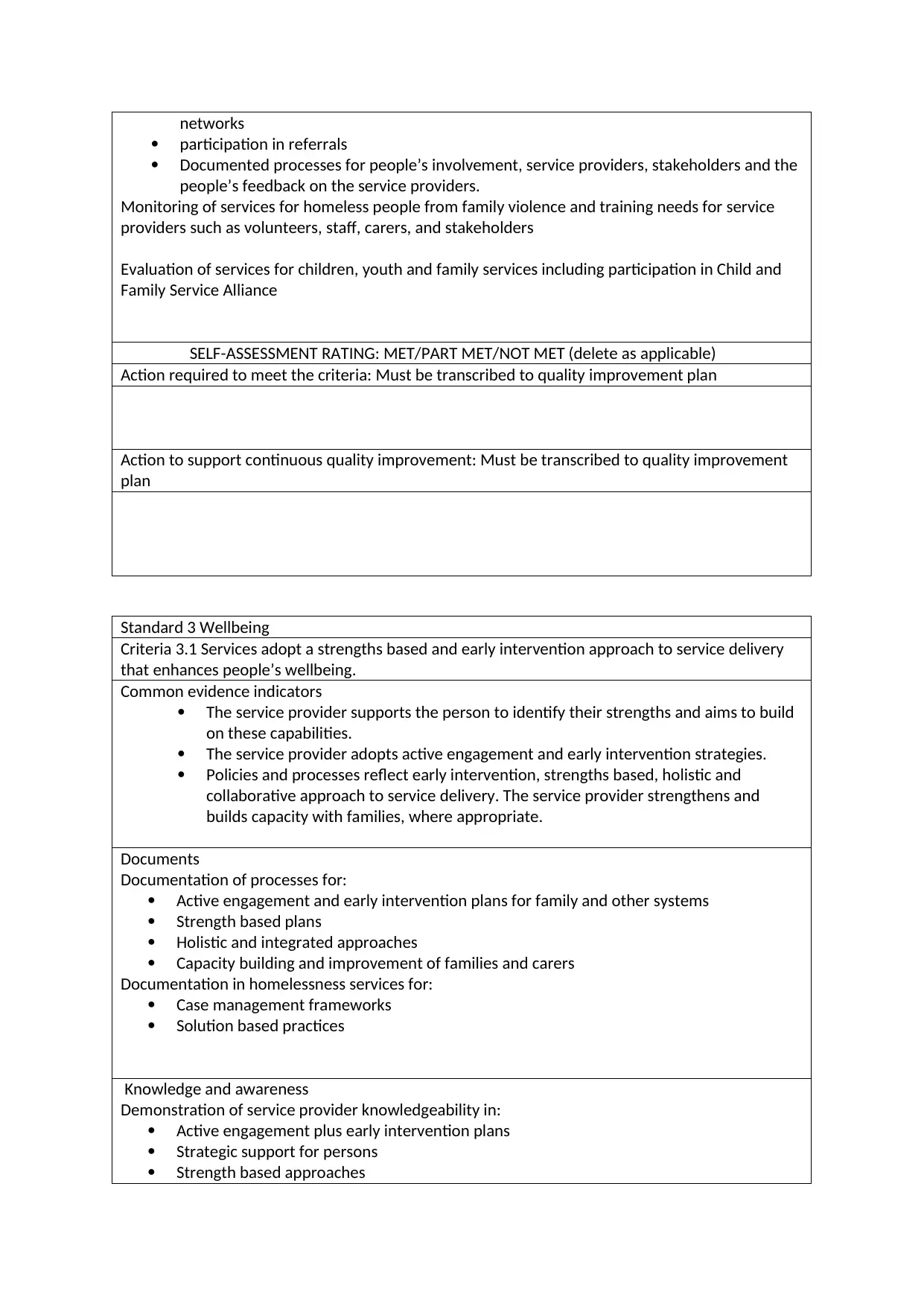
networks
participation in referrals
Documented processes for people’s involvement, service providers, stakeholders and the
people’s feedback on the service providers.
Monitoring of services for homeless people from family violence and training needs for service
providers such as volunteers, staff, carers, and stakeholders
Evaluation of services for children, youth and family services including participation in Child and
Family Service Alliance
SELF-ASSESSMENT RATING: MET/PART MET/NOT MET (delete as applicable)
Action required to meet the criteria: Must be transcribed to quality improvement plan
Action to support continuous quality improvement: Must be transcribed to quality improvement
plan
Standard 3 Wellbeing
Criteria 3.1 Services adopt a strengths based and early intervention approach to service delivery
that enhances people’s wellbeing.
Common evidence indicators
The service provider supports the person to identify their strengths and aims to build
on these capabilities.
The service provider adopts active engagement and early intervention strategies.
Policies and processes reflect early intervention, strengths based, holistic and
collaborative approach to service delivery. The service provider strengthens and
builds capacity with families, where appropriate.
Documents
Documentation of processes for:
Active engagement and early intervention plans for family and other systems
Strength based plans
Holistic and integrated approaches
Capacity building and improvement of families and carers
Documentation in homelessness services for:
Case management frameworks
Solution based practices
Knowledge and awareness
Demonstration of service provider knowledgeability in:
Active engagement plus early intervention plans
Strategic support for persons
Strength based approaches
participation in referrals
Documented processes for people’s involvement, service providers, stakeholders and the
people’s feedback on the service providers.
Monitoring of services for homeless people from family violence and training needs for service
providers such as volunteers, staff, carers, and stakeholders
Evaluation of services for children, youth and family services including participation in Child and
Family Service Alliance
SELF-ASSESSMENT RATING: MET/PART MET/NOT MET (delete as applicable)
Action required to meet the criteria: Must be transcribed to quality improvement plan
Action to support continuous quality improvement: Must be transcribed to quality improvement
plan
Standard 3 Wellbeing
Criteria 3.1 Services adopt a strengths based and early intervention approach to service delivery
that enhances people’s wellbeing.
Common evidence indicators
The service provider supports the person to identify their strengths and aims to build
on these capabilities.
The service provider adopts active engagement and early intervention strategies.
Policies and processes reflect early intervention, strengths based, holistic and
collaborative approach to service delivery. The service provider strengthens and
builds capacity with families, where appropriate.
Documents
Documentation of processes for:
Active engagement and early intervention plans for family and other systems
Strength based plans
Holistic and integrated approaches
Capacity building and improvement of families and carers
Documentation in homelessness services for:
Case management frameworks
Solution based practices
Knowledge and awareness
Demonstration of service provider knowledgeability in:
Active engagement plus early intervention plans
Strategic support for persons
Strength based approaches
Paraphrase This Document
Need a fresh take? Get an instant paraphrase of this document with our AI Paraphraser
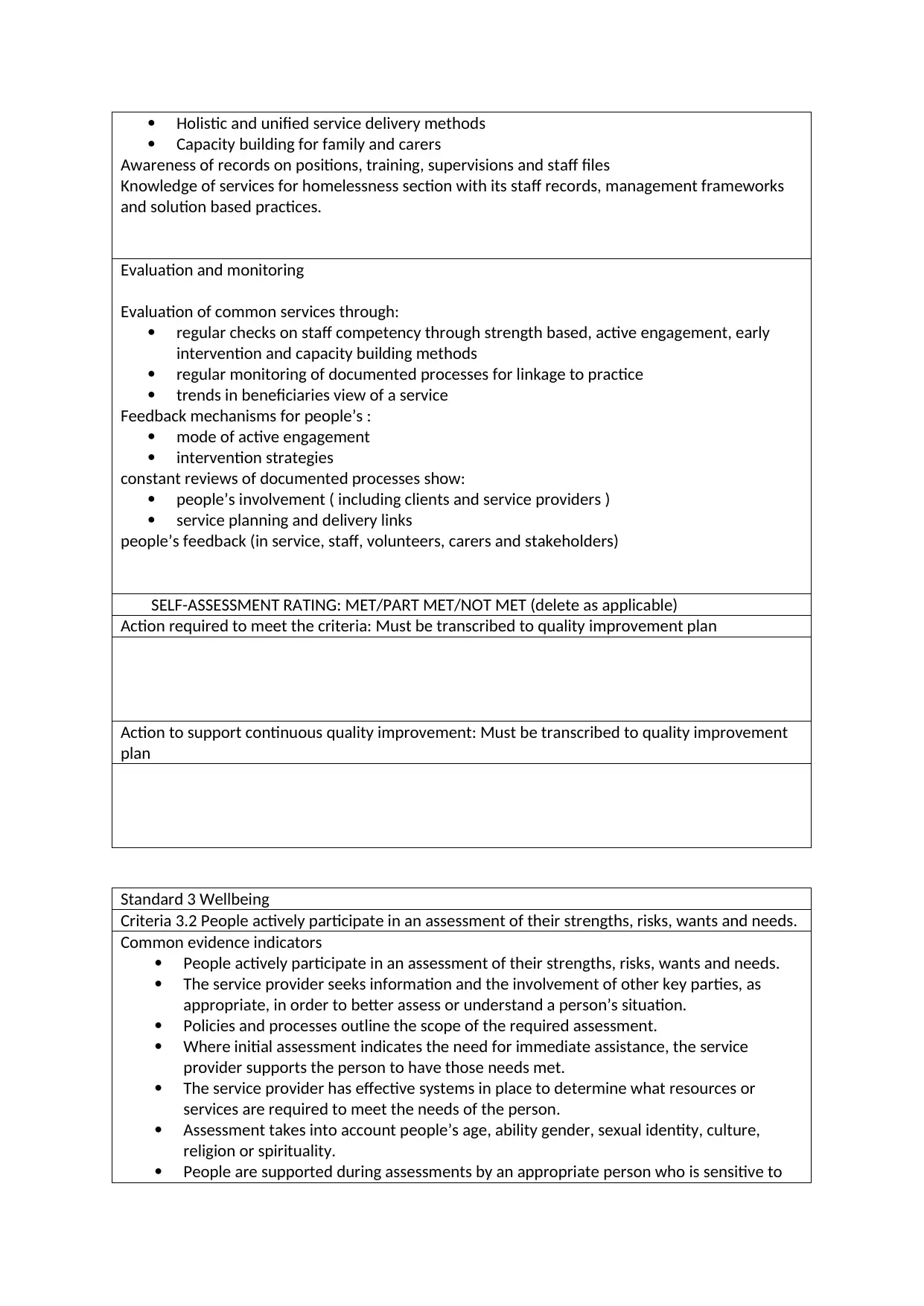
Holistic and unified service delivery methods
Capacity building for family and carers
Awareness of records on positions, training, supervisions and staff files
Knowledge of services for homelessness section with its staff records, management frameworks
and solution based practices.
Evaluation and monitoring
Evaluation of common services through:
regular checks on staff competency through strength based, active engagement, early
intervention and capacity building methods
regular monitoring of documented processes for linkage to practice
trends in beneficiaries view of a service
Feedback mechanisms for people’s :
mode of active engagement
intervention strategies
constant reviews of documented processes show:
people’s involvement ( including clients and service providers )
service planning and delivery links
people’s feedback (in service, staff, volunteers, carers and stakeholders)
SELF-ASSESSMENT RATING: MET/PART MET/NOT MET (delete as applicable)
Action required to meet the criteria: Must be transcribed to quality improvement plan
Action to support continuous quality improvement: Must be transcribed to quality improvement
plan
Standard 3 Wellbeing
Criteria 3.2 People actively participate in an assessment of their strengths, risks, wants and needs.
Common evidence indicators
People actively participate in an assessment of their strengths, risks, wants and needs.
The service provider seeks information and the involvement of other key parties, as
appropriate, in order to better assess or understand a person’s situation.
Policies and processes outline the scope of the required assessment.
Where initial assessment indicates the need for immediate assistance, the service
provider supports the person to have those needs met.
The service provider has effective systems in place to determine what resources or
services are required to meet the needs of the person.
Assessment takes into account people’s age, ability gender, sexual identity, culture,
religion or spirituality.
People are supported during assessments by an appropriate person who is sensitive to
Capacity building for family and carers
Awareness of records on positions, training, supervisions and staff files
Knowledge of services for homelessness section with its staff records, management frameworks
and solution based practices.
Evaluation and monitoring
Evaluation of common services through:
regular checks on staff competency through strength based, active engagement, early
intervention and capacity building methods
regular monitoring of documented processes for linkage to practice
trends in beneficiaries view of a service
Feedback mechanisms for people’s :
mode of active engagement
intervention strategies
constant reviews of documented processes show:
people’s involvement ( including clients and service providers )
service planning and delivery links
people’s feedback (in service, staff, volunteers, carers and stakeholders)
SELF-ASSESSMENT RATING: MET/PART MET/NOT MET (delete as applicable)
Action required to meet the criteria: Must be transcribed to quality improvement plan
Action to support continuous quality improvement: Must be transcribed to quality improvement
plan
Standard 3 Wellbeing
Criteria 3.2 People actively participate in an assessment of their strengths, risks, wants and needs.
Common evidence indicators
People actively participate in an assessment of their strengths, risks, wants and needs.
The service provider seeks information and the involvement of other key parties, as
appropriate, in order to better assess or understand a person’s situation.
Policies and processes outline the scope of the required assessment.
Where initial assessment indicates the need for immediate assistance, the service
provider supports the person to have those needs met.
The service provider has effective systems in place to determine what resources or
services are required to meet the needs of the person.
Assessment takes into account people’s age, ability gender, sexual identity, culture,
religion or spirituality.
People are supported during assessments by an appropriate person who is sensitive to
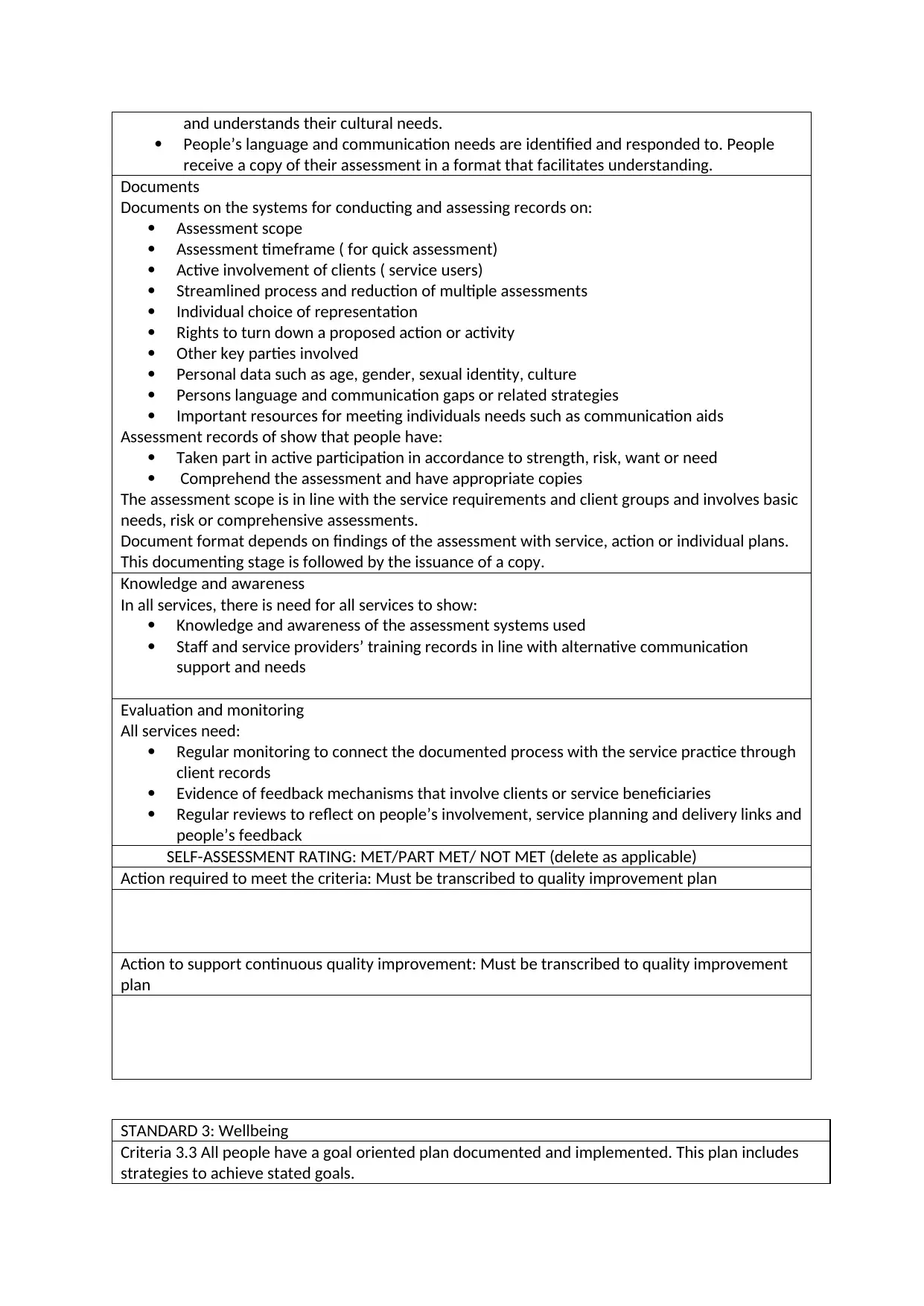
and understands their cultural needs.
People’s language and communication needs are identified and responded to. People
receive a copy of their assessment in a format that facilitates understanding.
Documents
Documents on the systems for conducting and assessing records on:
Assessment scope
Assessment timeframe ( for quick assessment)
Active involvement of clients ( service users)
Streamlined process and reduction of multiple assessments
Individual choice of representation
Rights to turn down a proposed action or activity
Other key parties involved
Personal data such as age, gender, sexual identity, culture
Persons language and communication gaps or related strategies
Important resources for meeting individuals needs such as communication aids
Assessment records of show that people have:
Taken part in active participation in accordance to strength, risk, want or need
Comprehend the assessment and have appropriate copies
The assessment scope is in line with the service requirements and client groups and involves basic
needs, risk or comprehensive assessments.
Document format depends on findings of the assessment with service, action or individual plans.
This documenting stage is followed by the issuance of a copy.
Knowledge and awareness
In all services, there is need for all services to show:
Knowledge and awareness of the assessment systems used
Staff and service providers’ training records in line with alternative communication
support and needs
Evaluation and monitoring
All services need:
Regular monitoring to connect the documented process with the service practice through
client records
Evidence of feedback mechanisms that involve clients or service beneficiaries
Regular reviews to reflect on people’s involvement, service planning and delivery links and
people’s feedback
SELF-ASSESSMENT RATING: MET/PART MET/ NOT MET (delete as applicable)
Action required to meet the criteria: Must be transcribed to quality improvement plan
Action to support continuous quality improvement: Must be transcribed to quality improvement
plan
STANDARD 3: Wellbeing
Criteria 3.3 All people have a goal oriented plan documented and implemented. This plan includes
strategies to achieve stated goals.
People’s language and communication needs are identified and responded to. People
receive a copy of their assessment in a format that facilitates understanding.
Documents
Documents on the systems for conducting and assessing records on:
Assessment scope
Assessment timeframe ( for quick assessment)
Active involvement of clients ( service users)
Streamlined process and reduction of multiple assessments
Individual choice of representation
Rights to turn down a proposed action or activity
Other key parties involved
Personal data such as age, gender, sexual identity, culture
Persons language and communication gaps or related strategies
Important resources for meeting individuals needs such as communication aids
Assessment records of show that people have:
Taken part in active participation in accordance to strength, risk, want or need
Comprehend the assessment and have appropriate copies
The assessment scope is in line with the service requirements and client groups and involves basic
needs, risk or comprehensive assessments.
Document format depends on findings of the assessment with service, action or individual plans.
This documenting stage is followed by the issuance of a copy.
Knowledge and awareness
In all services, there is need for all services to show:
Knowledge and awareness of the assessment systems used
Staff and service providers’ training records in line with alternative communication
support and needs
Evaluation and monitoring
All services need:
Regular monitoring to connect the documented process with the service practice through
client records
Evidence of feedback mechanisms that involve clients or service beneficiaries
Regular reviews to reflect on people’s involvement, service planning and delivery links and
people’s feedback
SELF-ASSESSMENT RATING: MET/PART MET/ NOT MET (delete as applicable)
Action required to meet the criteria: Must be transcribed to quality improvement plan
Action to support continuous quality improvement: Must be transcribed to quality improvement
plan
STANDARD 3: Wellbeing
Criteria 3.3 All people have a goal oriented plan documented and implemented. This plan includes
strategies to achieve stated goals.
⊘ This is a preview!⊘
Do you want full access?
Subscribe today to unlock all pages.

Trusted by 1+ million students worldwide
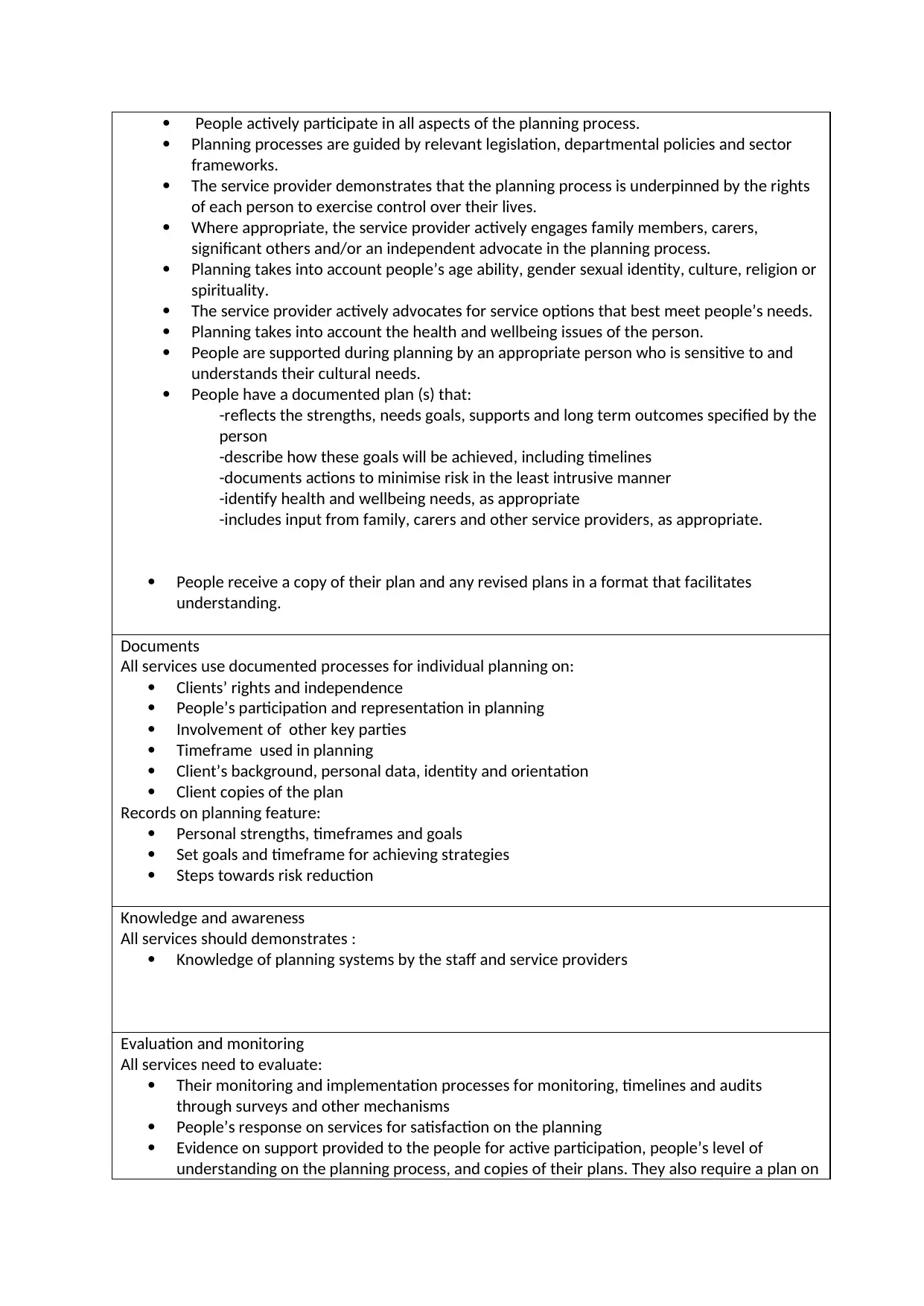
People actively participate in all aspects of the planning process.
Planning processes are guided by relevant legislation, departmental policies and sector
frameworks.
The service provider demonstrates that the planning process is underpinned by the rights
of each person to exercise control over their lives.
Where appropriate, the service provider actively engages family members, carers,
significant others and/or an independent advocate in the planning process.
Planning takes into account people’s age ability, gender sexual identity, culture, religion or
spirituality.
The service provider actively advocates for service options that best meet people’s needs.
Planning takes into account the health and wellbeing issues of the person.
People are supported during planning by an appropriate person who is sensitive to and
understands their cultural needs.
People have a documented plan (s) that:
-reflects the strengths, needs goals, supports and long term outcomes specified by the
person
-describe how these goals will be achieved, including timelines
-documents actions to minimise risk in the least intrusive manner
-identify health and wellbeing needs, as appropriate
-includes input from family, carers and other service providers, as appropriate.
People receive a copy of their plan and any revised plans in a format that facilitates
understanding.
Documents
All services use documented processes for individual planning on:
Clients’ rights and independence
People’s participation and representation in planning
Involvement of other key parties
Timeframe used in planning
Client’s background, personal data, identity and orientation
Client copies of the plan
Records on planning feature:
Personal strengths, timeframes and goals
Set goals and timeframe for achieving strategies
Steps towards risk reduction
Knowledge and awareness
All services should demonstrates :
Knowledge of planning systems by the staff and service providers
Evaluation and monitoring
All services need to evaluate:
Their monitoring and implementation processes for monitoring, timelines and audits
through surveys and other mechanisms
People’s response on services for satisfaction on the planning
Evidence on support provided to the people for active participation, people’s level of
understanding on the planning process, and copies of their plans. They also require a plan on
Planning processes are guided by relevant legislation, departmental policies and sector
frameworks.
The service provider demonstrates that the planning process is underpinned by the rights
of each person to exercise control over their lives.
Where appropriate, the service provider actively engages family members, carers,
significant others and/or an independent advocate in the planning process.
Planning takes into account people’s age ability, gender sexual identity, culture, religion or
spirituality.
The service provider actively advocates for service options that best meet people’s needs.
Planning takes into account the health and wellbeing issues of the person.
People are supported during planning by an appropriate person who is sensitive to and
understands their cultural needs.
People have a documented plan (s) that:
-reflects the strengths, needs goals, supports and long term outcomes specified by the
person
-describe how these goals will be achieved, including timelines
-documents actions to minimise risk in the least intrusive manner
-identify health and wellbeing needs, as appropriate
-includes input from family, carers and other service providers, as appropriate.
People receive a copy of their plan and any revised plans in a format that facilitates
understanding.
Documents
All services use documented processes for individual planning on:
Clients’ rights and independence
People’s participation and representation in planning
Involvement of other key parties
Timeframe used in planning
Client’s background, personal data, identity and orientation
Client copies of the plan
Records on planning feature:
Personal strengths, timeframes and goals
Set goals and timeframe for achieving strategies
Steps towards risk reduction
Knowledge and awareness
All services should demonstrates :
Knowledge of planning systems by the staff and service providers
Evaluation and monitoring
All services need to evaluate:
Their monitoring and implementation processes for monitoring, timelines and audits
through surveys and other mechanisms
People’s response on services for satisfaction on the planning
Evidence on support provided to the people for active participation, people’s level of
understanding on the planning process, and copies of their plans. They also require a plan on
Paraphrase This Document
Need a fresh take? Get an instant paraphrase of this document with our AI Paraphraser
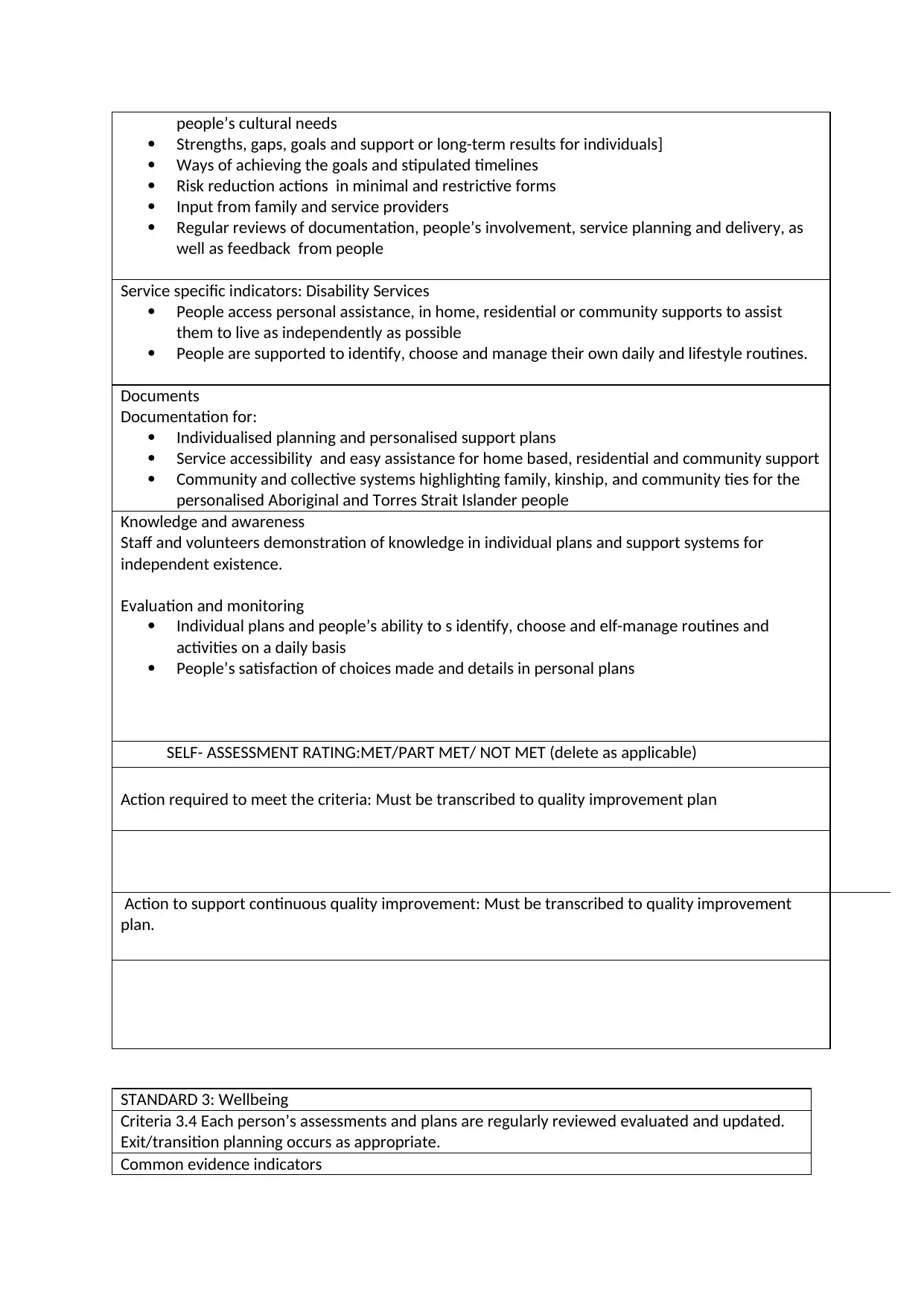
people’s cultural needs
Strengths, gaps, goals and support or long-term results for individuals]
Ways of achieving the goals and stipulated timelines
Risk reduction actions in minimal and restrictive forms
Input from family and service providers
Regular reviews of documentation, people’s involvement, service planning and delivery, as
well as feedback from people
Service specific indicators: Disability Services
People access personal assistance, in home, residential or community supports to assist
them to live as independently as possible
People are supported to identify, choose and manage their own daily and lifestyle routines.
Documents
Documentation for:
Individualised planning and personalised support plans
Service accessibility and easy assistance for home based, residential and community support
Community and collective systems highlighting family, kinship, and community ties for the
personalised Aboriginal and Torres Strait Islander people
Knowledge and awareness
Staff and volunteers demonstration of knowledge in individual plans and support systems for
independent existence.
Evaluation and monitoring
Individual plans and people’s ability to s identify, choose and elf-manage routines and
activities on a daily basis
People’s satisfaction of choices made and details in personal plans
SELF- ASSESSMENT RATING:MET/PART MET/ NOT MET (delete as applicable)
Action required to meet the criteria: Must be transcribed to quality improvement plan
Action to support continuous quality improvement: Must be transcribed to quality improvement
plan.
STANDARD 3: Wellbeing
Criteria 3.4 Each person’s assessments and plans are regularly reviewed evaluated and updated.
Exit/transition planning occurs as appropriate.
Common evidence indicators
Strengths, gaps, goals and support or long-term results for individuals]
Ways of achieving the goals and stipulated timelines
Risk reduction actions in minimal and restrictive forms
Input from family and service providers
Regular reviews of documentation, people’s involvement, service planning and delivery, as
well as feedback from people
Service specific indicators: Disability Services
People access personal assistance, in home, residential or community supports to assist
them to live as independently as possible
People are supported to identify, choose and manage their own daily and lifestyle routines.
Documents
Documentation for:
Individualised planning and personalised support plans
Service accessibility and easy assistance for home based, residential and community support
Community and collective systems highlighting family, kinship, and community ties for the
personalised Aboriginal and Torres Strait Islander people
Knowledge and awareness
Staff and volunteers demonstration of knowledge in individual plans and support systems for
independent existence.
Evaluation and monitoring
Individual plans and people’s ability to s identify, choose and elf-manage routines and
activities on a daily basis
People’s satisfaction of choices made and details in personal plans
SELF- ASSESSMENT RATING:MET/PART MET/ NOT MET (delete as applicable)
Action required to meet the criteria: Must be transcribed to quality improvement plan
Action to support continuous quality improvement: Must be transcribed to quality improvement
plan.
STANDARD 3: Wellbeing
Criteria 3.4 Each person’s assessments and plans are regularly reviewed evaluated and updated.
Exit/transition planning occurs as appropriate.
Common evidence indicators
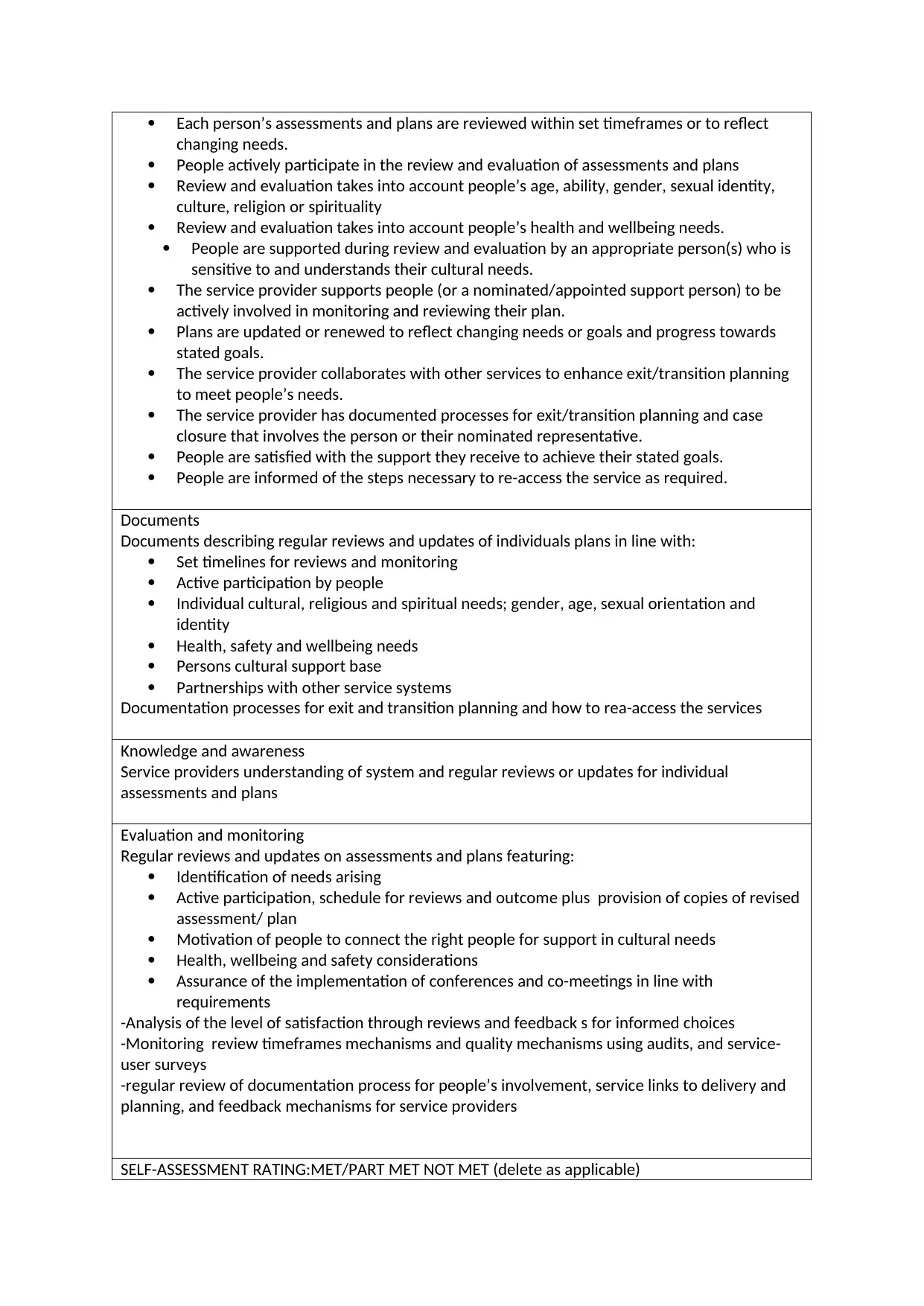
Each person’s assessments and plans are reviewed within set timeframes or to reflect
changing needs.
People actively participate in the review and evaluation of assessments and plans
Review and evaluation takes into account people’s age, ability, gender, sexual identity,
culture, religion or spirituality
Review and evaluation takes into account people’s health and wellbeing needs.
People are supported during review and evaluation by an appropriate person(s) who is
sensitive to and understands their cultural needs.
The service provider supports people (or a nominated/appointed support person) to be
actively involved in monitoring and reviewing their plan.
Plans are updated or renewed to reflect changing needs or goals and progress towards
stated goals.
The service provider collaborates with other services to enhance exit/transition planning
to meet people’s needs.
The service provider has documented processes for exit/transition planning and case
closure that involves the person or their nominated representative.
People are satisfied with the support they receive to achieve their stated goals.
People are informed of the steps necessary to re-access the service as required.
Documents
Documents describing regular reviews and updates of individuals plans in line with:
Set timelines for reviews and monitoring
Active participation by people
Individual cultural, religious and spiritual needs; gender, age, sexual orientation and
identity
Health, safety and wellbeing needs
Persons cultural support base
Partnerships with other service systems
Documentation processes for exit and transition planning and how to rea-access the services
Knowledge and awareness
Service providers understanding of system and regular reviews or updates for individual
assessments and plans
Evaluation and monitoring
Regular reviews and updates on assessments and plans featuring:
Identification of needs arising
Active participation, schedule for reviews and outcome plus provision of copies of revised
assessment/ plan
Motivation of people to connect the right people for support in cultural needs
Health, wellbeing and safety considerations
Assurance of the implementation of conferences and co-meetings in line with
requirements
-Analysis of the level of satisfaction through reviews and feedback s for informed choices
-Monitoring review timeframes mechanisms and quality mechanisms using audits, and service-
user surveys
-regular review of documentation process for people’s involvement, service links to delivery and
planning, and feedback mechanisms for service providers
SELF-ASSESSMENT RATING:MET/PART MET NOT MET (delete as applicable)
changing needs.
People actively participate in the review and evaluation of assessments and plans
Review and evaluation takes into account people’s age, ability, gender, sexual identity,
culture, religion or spirituality
Review and evaluation takes into account people’s health and wellbeing needs.
People are supported during review and evaluation by an appropriate person(s) who is
sensitive to and understands their cultural needs.
The service provider supports people (or a nominated/appointed support person) to be
actively involved in monitoring and reviewing their plan.
Plans are updated or renewed to reflect changing needs or goals and progress towards
stated goals.
The service provider collaborates with other services to enhance exit/transition planning
to meet people’s needs.
The service provider has documented processes for exit/transition planning and case
closure that involves the person or their nominated representative.
People are satisfied with the support they receive to achieve their stated goals.
People are informed of the steps necessary to re-access the service as required.
Documents
Documents describing regular reviews and updates of individuals plans in line with:
Set timelines for reviews and monitoring
Active participation by people
Individual cultural, religious and spiritual needs; gender, age, sexual orientation and
identity
Health, safety and wellbeing needs
Persons cultural support base
Partnerships with other service systems
Documentation processes for exit and transition planning and how to rea-access the services
Knowledge and awareness
Service providers understanding of system and regular reviews or updates for individual
assessments and plans
Evaluation and monitoring
Regular reviews and updates on assessments and plans featuring:
Identification of needs arising
Active participation, schedule for reviews and outcome plus provision of copies of revised
assessment/ plan
Motivation of people to connect the right people for support in cultural needs
Health, wellbeing and safety considerations
Assurance of the implementation of conferences and co-meetings in line with
requirements
-Analysis of the level of satisfaction through reviews and feedback s for informed choices
-Monitoring review timeframes mechanisms and quality mechanisms using audits, and service-
user surveys
-regular review of documentation process for people’s involvement, service links to delivery and
planning, and feedback mechanisms for service providers
SELF-ASSESSMENT RATING:MET/PART MET NOT MET (delete as applicable)
⊘ This is a preview!⊘
Do you want full access?
Subscribe today to unlock all pages.

Trusted by 1+ million students worldwide
1 out of 30
Related Documents
Your All-in-One AI-Powered Toolkit for Academic Success.
+13062052269
info@desklib.com
Available 24*7 on WhatsApp / Email
![[object Object]](/_next/static/media/star-bottom.7253800d.svg)
Unlock your academic potential
Copyright © 2020–2025 A2Z Services. All Rights Reserved. Developed and managed by ZUCOL.



